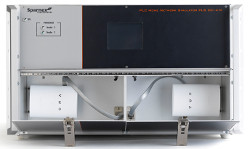PLS 2014-16
Simulating the home network for testing PLC devices
 |
The PLS 2014-15 provides an integrated test system for automated or manual compliance verification of PLC Devices Under Test (DUT)
ABOUT PLC TESTING
PLC technology in the home is using ordinary power cables and thus is subject to a
number of interferences that will define the performance of the broadband connection at every
access point. The quality depends on the type of power cables and the topology of the
wiring inside the house, which is different than a point-to-point connection like with a DSL network. Other influences coming from RFI alike disturbers, as well as interference caused by impulses on the line, will have impact on the broadband connection in terms of maximum speed and possible re-synchronization of modems. Impulses are caused by on/off switching of various sources, like i.e. washing machine, hair dryer, vacuum cleaner, electrical oven/ cooking plates, TV, lights (neon, halogen, etc.), air-conditioning, etc. These types of
impulses are detrimental to the data signal.
The PLS2016 is developed for R&D engineers as well as for people in charge of Quality Assurance in order to set a minimum benchmark under various fixed and realistic network conditions. TELCO Operators use the PLS 2014-16 to know what the impact is of PLC on their service since it has become a popular technology that is used to make the broadband service available at several points within the home.
The PLS 2014-16 is a PLC testing platform that allows simulating the in-home network in both star as well as in bus mode, even in a combination of both. The user can select from
several topologies, whereby each network can have up to 10 connection points. The distance between each connection point on the network is 6 meters (20 feet) or 3 meters (10 feet) using different type of power cable characteristics.
Features
• Selection of 4 loop topologies
• Different cable types for Europe: 0,75 mm, 1,5 mm and 2,5 mm
• Different cable types for Asia: 1,6 mm, 2 mm and 5,5 mm
• PLC (DUT) or ‘load’ per connection point
• Remote control for automation Loop 1-6 and on/off function